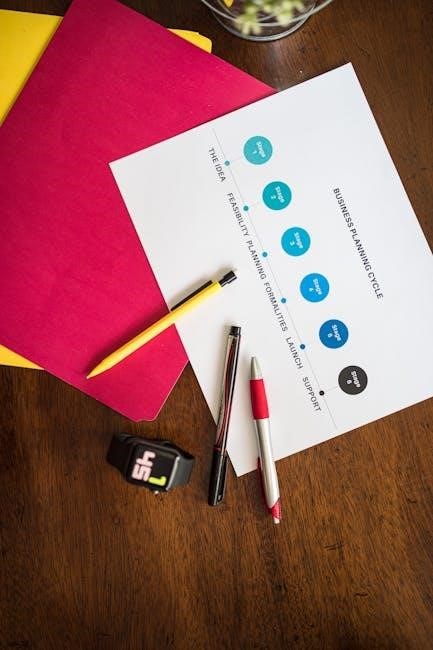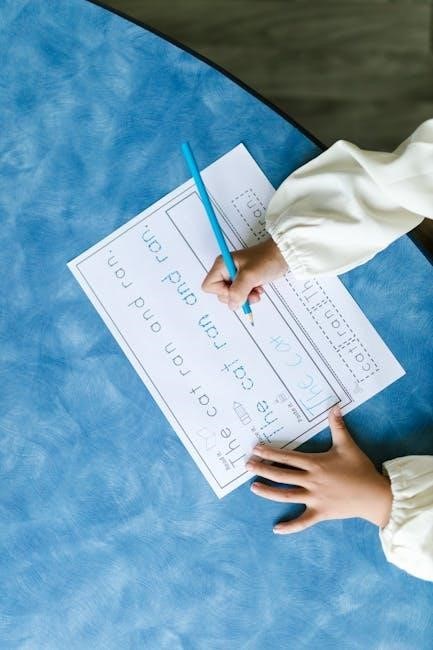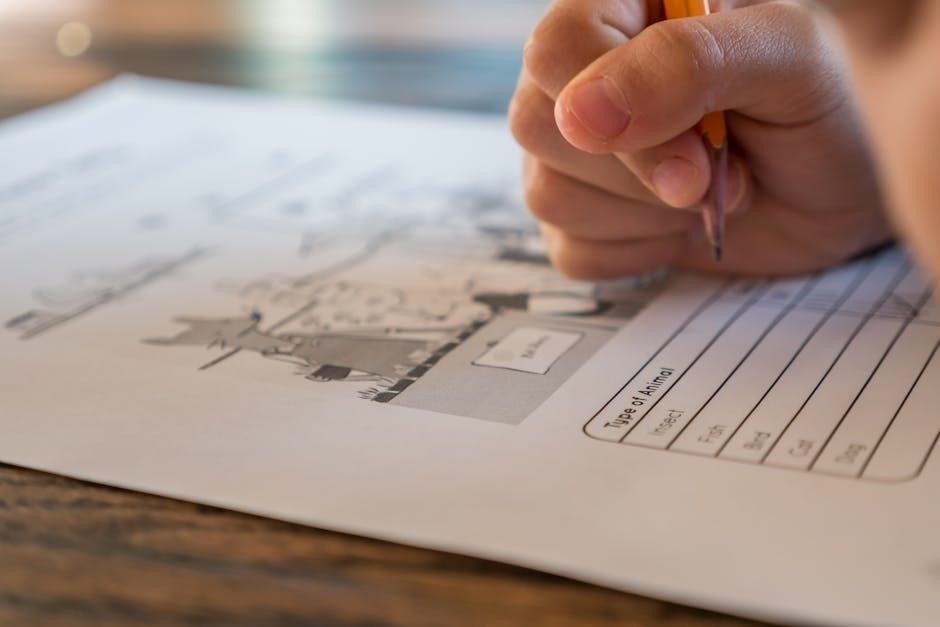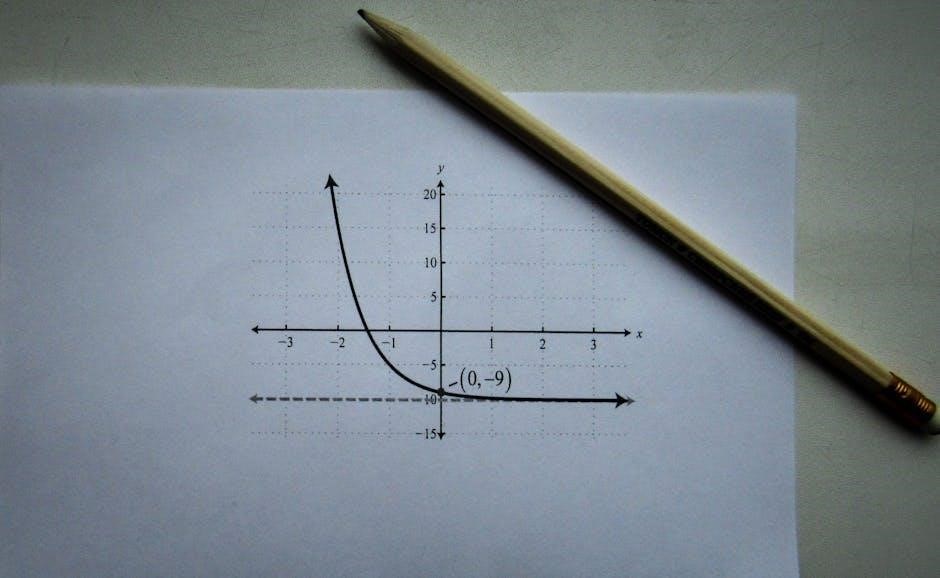Welcome to our guide on mastering decimal multiplication! This section introduces the fundamental concepts and practical applications of multiplying decimals, helping you understand place value and correct decimal placement. With free PDF worksheets and clear examples, you’ll gain confidence in solving real-world problems involving decimal multiplication.
1.1 Importance of Mastering Decimal Multiplication
Mastering decimal multiplication is essential for solving real-world problems, such as calculating costs, measurements, and financial transactions. It enhances mathematical accuracy and builds a strong foundation for advanced math concepts. Practicing with worksheets helps students grasp place value, ensuring correct decimal placement and avoiding errors. Decimal multiplication is vital in everyday scenarios, like determining total prices or budgeting, making it a skill that improves both academic and practical problem-solving abilities. Regular practice with worksheets reinforces confidence and fluency in handling decimal operations.
1.2 Overview of Decimal Multiplication Concepts
Multiplying decimals involves understanding place value and correctly placing the decimal point in the product. The process begins by ignoring the decimal points and multiplying the numbers as whole numbers. The decimal point is then placed in the final answer based on the total number of decimal places in the original numbers. For example, multiplying 1.29 by 6 involves treating it as 129 x 6, then adjusting the decimal point. Practice worksheets provide structured exercises to master these concepts, ensuring accuracy and confidence in solving various decimal multiplication problems.

Key Concepts in Multiplying Decimals
Mastering decimal multiplication requires understanding place value, counting decimal places, and using the shortcut method to place the decimal correctly in the product.
2.1 Understanding Place Value in Decimals
Place value is crucial in decimal multiplication. Each digit represents tenths, hundredths, or thousandths. For example, in 1.29, 1 is in the ones place, 2 in tenths, and 9 in hundredths. Accurately identifying these positions ensures correct decimal placement during multiplication. Practice with PDF worksheets helps reinforce this concept, making it easier to apply in problems like calculating the total cost of 6 bottles of cola at $1.29 each. This foundational understanding is essential for mastering decimal operations.
2.2 Counting Decimal Places
Counting decimal places is vital for accurate multiplication. Each number’s decimal places are added together to determine the product’s decimal placement. For example, multiplying 1.29 (two decimal places) by 6 (no decimal places) results in a product with two decimal places. This step ensures precision. Worksheets provide exercises to practice counting and placing decimals correctly, reinforcing the skill. Mastering this process is essential for solving problems like calculating Regan’s weekly pay or the cost of multiple cola bottles.
2.3 The Shortcut Method for Decimal Multiplication
The shortcut method simplifies decimal multiplication by ignoring the decimal points initially. Multiply the numbers as whole numbers first, then count the total decimal places from both multiplicands. Place the decimal point in the product by moving it left from the end, equal to the total number of decimal places counted. For example, multiplying 1.29 (two decimal places) by 6 results in 7.74 after correctly placing the decimal. This method streamlines calculations and reduces errors, proving especially useful for problems like calculating total costs or scaling recipes.

Step-by-Step Guide to Multiplying Decimals
Master decimal multiplication in three easy steps: multiply as whole numbers, count total decimal places, and place the decimal in the product accordingly for accurate results.
3.1 Setting Up the Multiplication Problem
Start by writing the numbers vertically, aligning their place values. Ensure decimals are positioned correctly for clarity. This setup helps maintain organization and reduces errors during calculation. Use worksheets to practice proper alignment and visualization of decimal points, enhancing your accuracy and confidence in solving multiplication problems effectively.
3.2 Multiplying as if There Were No Decimal Points
Ignore the decimal points and multiply the numbers as if they were whole numbers. For example, to multiply 4.2 by 2.3, treat them as 42 and 23. Multiply 42 by 23 to get 966. Count the total number of decimal places in the original numbers (1 in 4.2 and 1 in 2.3, totaling 2) and place the decimal point in the product two places from the right, resulting in 9.66. This method ensures accuracy and simplifies the multiplication process.
3.3 Placing the Decimal Point in the Final Answer
After multiplying the numbers as whole numbers, count the total number of decimal places in both original numbers. For example, if one number has two decimal places and the other has one, the product should have three decimal places. Place the decimal point in the final answer accordingly, starting from the right. This ensures the result is accurate and properly aligned. Always double-check the number of decimal places to avoid errors in your calculations.
3.4 Solving Word Problems Involving Decimal Multiplication
Word problems involving decimal multiplication require applying your skills to real-world scenarios. For example, calculating the total cost of items or determining distances. To solve these, identify the numbers to multiply, then apply the decimal multiplication steps. Practice with worksheets helps build confidence in translating practical problems into mathematical solutions. Always read carefully, highlight key numbers, and estimate to ensure your answers make sense. Worksheets with word problems, like calculating Regan’s hourly pay or cola bottle costs, provide hands-on experience for mastering these skills.

Common Mistakes in Multiplying Decimals
Common errors include forgetting to count decimal places and incorrectly placing the decimal point in the final answer. These mistakes can lead to inaccurate results, emphasizing the need for careful attention to detail and structured practice with worksheets to build precision and confidence in decimal multiplication.
4.1 Forgetting to Count Decimal Places
One of the most frequent errors in decimal multiplication is neglecting to count the total number of decimal places in the numbers being multiplied. This oversight often occurs when students rush through problems or fail to pay attention to the decimal points. Forgetting to count decimal places leads to incorrect placement of the decimal in the final product, resulting in an answer that is either too large or too small. To avoid this mistake, it is essential to carefully count the decimal places in both the multiplicand and the multiplier before placing the decimal in the final answer. Practicing with structured worksheets and reviewing examples can help build this habit and reduce errors. Additionally, emphasizing the importance of decimal placement during practice sessions ensures that students develop a strong foundation in multiplying decimals accurately. By mastering this step, learners can improve their overall performance in decimal multiplication tasks and gain confidence in their math skills. Regular review and reinforcement of this concept are crucial for long-term understanding and proficiency.
4.2 Improper Placement of the Decimal Point
Improper placement of the decimal point is a common mistake when multiplying decimals. After multiplying the numbers as whole numbers, many students incorrectly place the decimal in the final product. This error occurs when the total number of decimal places from both numbers is miscalculated. For example, multiplying 2.5 (one decimal place) by 3.2 (one decimal place) requires placing the decimal two places from the right in the product (8.00). Failing to do so results in an incorrect answer. Always count the total decimal places carefully and place the decimal point accurately to ensure the correct product. Regular practice with worksheets helps build this skill and reduces errors over time.

Benefits of Using Multiplying Decimals Worksheets
Multiplying decimals worksheets provide structured practice, helping students master decimal multiplication through varied exercises and real-world applications. They build confidence and improve math skills effectively and engagingly.
5.1 Providing Structured Practice
Multiplying decimals worksheets offer organized exercises to help students systematically improve their skills. These resources include a variety of problems, such as multiplying decimals by whole numbers, other decimals, or powers of ten. Structured practice ensures learners grasp foundational concepts before advancing to complex calculations. Worksheets often feature word problems and mixed decimal place exercises, catering to different learning paces. Regular practice builds confidence and reinforces understanding, making these resources invaluable for both classroom and independent learning environments.
5.2 Building Confidence in Decimal Multiplication
Engaging with multiplying decimals worksheets helps students build confidence by reinforcing their understanding of decimal multiplication. As learners progress through structured exercises, they gain a sense of accomplishment with each correct answer. Worksheets cater to different learning paces, offering varied problems that challenge without overwhelming. Word problems and practical scenarios further enhance engagement, allowing students to see the real-world relevance of their skills. Regular practice fosters resilience and a positive attitude toward math, making decimal multiplication feel achievable and mastery within reach.

Levels of Difficulty in Worksheets
Multiplying decimals worksheets offer varying difficulty levels, starting with simple problems like whole numbers and advancing to complex multi-decimal place calculations, ensuring a smooth learning progression.

6.1 Multiplying Decimals by Whole Numbers
Multiplying decimals by whole numbers is a foundational skill that builds confidence in handling more complex decimal problems. Start by ignoring the decimal point and multiplying the numbers as whole numbers. Then, place the decimal point in the product based on the total number of decimal places in the original decimal number. For example, multiplying 4.2 by 5 gives 21.0. This method simplifies the process and ensures accuracy. Worksheets often include problems like 3.7 x 4 or 2.9 x 6, making it easy to practice and master this essential math concept.
6.2 Multiplying Decimals by Other Decimals
Multiplying decimals by other decimals requires careful attention to place value and decimal placement. To solve, multiply the numbers as if they were whole numbers, then count the total number of decimal places in both factors. Place the decimal point in the product accordingly. For example, multiplying 1.29 by 1.4 involves multiplying 129 by 14 to get 1806, then placing the decimal three places from the right, resulting in 18.06. Worksheets often include problems like 3.52 x 2.4 or 4.92 x 0.34 to practice this skill.
6.3 Advanced Problems Involving Multiple Decimal Places
Advanced decimal multiplication involves problems with multiple decimal places, requiring precise counting and placement of the decimal point. For instance, multiplying 1.29 (two decimal places) by 1.4 (one decimal place) results in 1.806, which becomes 18.06 when adjusted for three decimal places. Worksheets often include challenges like 9.2 x 7.15 or 6.3 x 2.46, ensuring mastery of complex calculations. These problems help build proficiency in handling decimals with varying place values, preparing learners for real-world financial and scientific applications.

Word Problems in Multiplying Decimals
Word problems in decimal multiplication involve real-world scenarios, such as calculating total costs, wages, or quantities. Practice with examples like Regan’s hourly pay or cola bottle totals to master practical applications.
7.1 Real-World Applications of Decimal Multiplication
Decimal multiplication is essential in everyday scenarios like calculating earnings, shopping, and budgeting. For instance, determining Regan’s weekly pay or the total cost of cola bottles involves multiplying decimals. These practical examples help students connect math to real life, making learning more relevant and engaging. Worksheets with such problems encourage mastery of decimal multiplication while preparing students for real-world financial and measurement tasks.
7.2 Solving Practical Scenarios with Decimal Products
Practical scenarios like budgeting, financial planning, and measuring materials require accurate decimal multiplication. For example, calculating the total cost of museum entry for a family or determining the price of multiple cola bottles involves multiplying decimals. Worksheets provide realistic problems that simulate these situations, helping learners apply their skills confidently. Regular practice with these exercises enhances problem-solving abilities and prepares individuals for everyday challenges involving money, measurements, and resource allocation.

Sources for Free Multiplying Decimals Worksheets
Find free multiplying decimals worksheets on educational websites like Super Teacher Worksheets. Download PDFs offering various skill levels, from basic to advanced problems, ideal for effective practice.
8.1 Websites Offering PDF Worksheets
Popular websites like Super Teacher Worksheets offer a wide range of free PDF worksheets for multiplying decimals. These resources provide exercises for various skill levels, from basic multiplication by whole numbers to complex problems involving multiple decimal places. Many websites allow customization, enabling users to select specific problem types, such as tenths, hundredths, or mixed decimal places. Additionally, these PDFs often include answer keys, making them ideal for self-study or classroom use. They cater to different learning needs, ensuring engaging and effective practice for students of all ages.
8.2 Workbooks and Printable Resources
Workbooks and printable resources provide comprehensive practice for mastering decimal multiplication. For example, the Multiplying Decimals Workbook, Level 1 offers 50 tests with an answer key, ideal for structured learning. Printable resources often include activity sheets, exercises, and word problems tailored for different skill levels. Many workbooks feature interactive activities, such as fill-in-the-blank exercises, to keep learners engaged. These resources are perfect for both classroom use and independent study, offering a hands-on approach to understanding decimal multiplication concepts and improving math skills through consistent practice.

Verifying Answers to Decimal Multiplication Problems
Verifying answers ensures accuracy in decimal multiplication. Use estimation to check reasonableness and calculate precisely to confirm results, building confidence in your math skills.
9.1 Using Estimation to Check Results
Estimation is a powerful tool for verifying decimal multiplication answers. By rounding numbers to their nearest whole numbers or simple decimals, you can quickly assess if your result makes sense. For example, if you multiply 4.5 by 3.2, estimating 4 by 3 gives 12, so your precise answer should be close to this range. This method helps catch errors and builds confidence in your calculations. Regular practice with estimation techniques ensures accuracy and efficiency in solving decimal multiplication problems. It’s an essential skill for mastering decimal operations and real-world applications.
9.2 Ensuring Accuracy in Calculations
To ensure accuracy in decimal multiplication, carefully count the total number of decimal places in both numbers being multiplied. This determines where to place the decimal point in the final product. Always align decimals when setting up the problem and double-check your work. Using structured worksheets can help you practice consistently and identify common mistakes. For precise results, avoid rushing through calculations and review each step. Regular practice with multiplying decimals worksheets builds proficiency and reduces errors, making real-world applications of decimal multiplication more manageable and accurate.
Multiplying decimals is a valuable skill with practical applications. Regular practice using worksheets enhances accuracy and confidence. Keep refining your skills for real-world problem-solving success!
10.1 Summarizing Key Takeaways
Mastering decimal multiplication is essential for solving real-world problems. Key concepts include understanding place value, counting decimal places, and correctly placing the decimal in the final product. Worksheets provide structured practice, helping build confidence and accuracy. Regular practice with various problems, from simple to advanced, reinforces skills. Verifying answers through estimation ensures reliability. By following step-by-step guides and avoiding common mistakes, learners can excel in decimal multiplication. Keep practicing to refine your skills and apply them effectively in everyday scenarios and more complex mathematical challenges.
10.2 Encouraging Further Practice
Consistent practice is key to mastering decimal multiplication. Utilize free PDF worksheets to reinforce concepts and explore various problem types. Engage with exercises involving whole numbers, multiple decimals, and word problems to build fluency. Regular practice helps reduce errors and boosts confidence. Encourage learners to solve real-world scenarios, applying their skills to practical situations. The more you practice, the more comfortable and accurate you’ll become with decimal multiplication. Make practice a habit to ensure long-term retention and mastery of this essential math skill.






